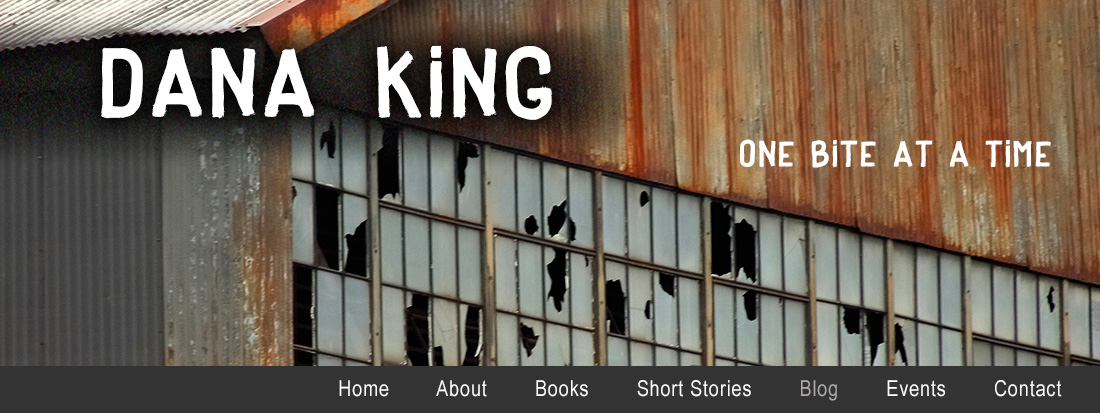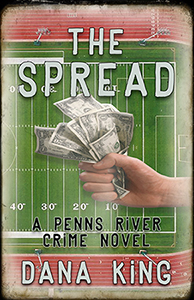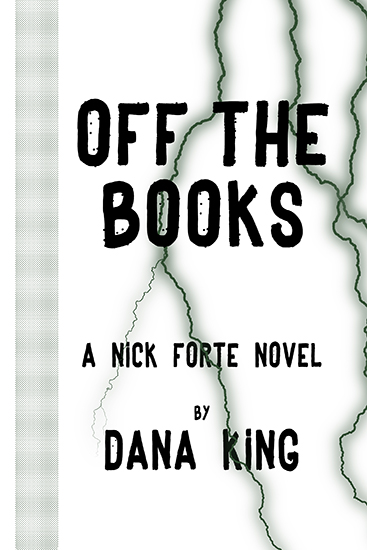 Declan Burke is the
author of Eightball Boogie (2003), The Big O (2007), Absolute Zero Cool (winner of the
Goldsboro “Last Laugh” Award for 2011 at Crimefest), Slaughter's Hound (sequel to Eightball Boogie, 2012), and his newest,
Crime Always Pays, which is a sequel to The Big O. (How there came to be so long between them is discussed
below.) A tireless supporter and champion of Irish crime fiction in his blog, Crime
Always Pays, he is the editor
of Down These Green Streets: Irish
Crime Writing In The 21st Century, and is the co-editor, with John Connolly, of Books To Die For (2012).
Declan Burke is the
author of Eightball Boogie (2003), The Big O (2007), Absolute Zero Cool (winner of the
Goldsboro “Last Laugh” Award for 2011 at Crimefest), Slaughter's Hound (sequel to Eightball Boogie, 2012), and his newest,
Crime Always Pays, which is a sequel to The Big O. (How there came to be so long between them is discussed
below.) A tireless supporter and champion of Irish crime fiction in his blog, Crime
Always Pays, he is the editor
of Down These Green Streets: Irish
Crime Writing In The 21st Century, and is the co-editor, with John Connolly, of Books To Die For (2012).
More than that, at
least to me, is he’s a damn good friend, an enthusiastic supporter of my work
who not only talked me out of quitting before I’d been published, but reached
across the sheugh to tell me what he thought of Grind Joint person-to-person. That’s why I’m particularly chuffed
to be able to so enthusiastically
endorse Crime Always Pays, which
combines the best elements of Elmore Leonard and Donald Westlake. (I shit you
not.)
Declan took time
from his busy schedule and family to
submit to the usual inordinate amount of questions from me.
One Bite at a Time: I
read a draft copy of Crime Always Pays, had to be five years ago. What
the hell took so long for it to be published?
Declan Burke:
Well, as John Lennon said, life is what happens while you’re busy making other
plans. Basically, the very lovely editor who signed Crime Always Pays as
the second of a two-book deal (the first being The Big O) was no longer
at that particular desk when the time came around for it to be published, so it
ended up being a very protracted process. In the end I bought back the rights
to The Big O and Crime Always Pays, and I was delighted last year
when the good people at Severn House decided they wanted to publish Crime
Always Pays.
OBAAT: Crime
Always Pays is a sequel to The Big O, and begins only a couple of
hours after The Big O ends. Did you have a sequel in mind all the time,
or were those characters so much fun you felt you had to keep the roll going?
DB: No, I didn’t have a
sequel in mind at the time, I don’t really work that way. It’s partly what you
suggest, that I had so much fun with those guys that I wanted to see what
happened to them after The Big O ended, if they couldn’t manage to
finagle themselves into an even bigger mess than before. It was also partly
because, when I was writing The Big O, it was in my mind largely a story
about Karen and Ray – and Karen, really. The more I thought about it, though,
the more I realised that I’d given Rossi a bum deal throughout that whole
story, and I wanted to give him the kind of second chance that life never gave
him, or that life, in reality, never gives to guys like him.
OBAAT: How
long did it take to write Crime Always Pays, start to finish?
DB: Crikey – how long is a
piece of string? If memory serves, the first draft took about four or five
months, and that went pretty well – I’d say the finished book is probably about
70% of the first draft. But, with life and other books and various other issues
getting in the way, it probably took about six years to get from writing the
first line to seeing it on a shelf.
OBAAT: Crime
Always Pays is a multi-POV story, to say the least. Seven characters share
in telling the story, but my favorite, by far, is Sleeps, the narcoleptic
getaway driver. How did you come up with him?
DB: I honestly can’t
remember. In the beginning Sleeps was just a guy who lends Rossi a hand getting
back on his feet after Rossi gets out of prison, but given that Rossi is
plagued by bad luck – a lot of it due to bad planning, it has to say – Sleeps
quickly became more of a hindrance than a help to Rossi, not least because he
comes to serve as Rossi’s conscience, and I just loved the idea of a getaway
driver who is prone to nodding off at the wheel. Actually, Sleeps is probably
my favourite character in Crime Always Pays too – at one point the book
was operating under the working title ‘Sleeps The Hero’.
OBAAT: The
Big O takes place all within a few miles. Crime Always Pays spans
Europe, from Ireland to the Greek Islands. Did you plan a broader scope from
the get-go, is that how things just worked out, or did you want to take a
vacation and thought it would be nice to write it off as research?
DB: I’d always wanted to
write a “road movie” book, but that’s not really a runner in Ireland, because
three or four hours would take you coast-to-coast, which would make for a
pretty short book. So I thought it would be fun to take Karen, Ray, Rossi et al
on the road. Once I decided that, they were only ever heading for the Greek
islands – I fell in love with the landscape of the Greek islands about 25 years
ago, and I’ve always wanted to set a story there. Finally, the year I wrote Crime
Always Pays, I knew I wouldn’t be getting a vacation. So the next best
thing was to write a story set in my favourite place – I got to spend a couple
of hours a day, for four or five months, in the Greek islands.
OBAAT:
Anna is a three-quarters wolf, one-quarter Husky mix that serves as a focal
point for much of what happens, as Karen’s devotion to her influences what
everyone else has to do in some way. It’s a brilliant way to create an organic
and ongoing complication. What made you think of such a device? (I apologize
for referring to her as a “device,” as she’s a well-rounded character of her
own.)
DB: I came up with Anna for
The Big O because I wanted Karen to have a serious responsibility and /
or an unusual reason for pulling hold-ups. The first thing that came to mind
was that Karen had a child to take care of, but that’s been done more than a
few times before, so I gave her a child-like and slightly unusual character in
Anna. Someone pointed out to me that there’s always some kind of wild (or
semi-wild) character in all of my books – there’s another dog in Slaughter’s
Hound, for example – and I guess it’s because, as you suggest, I like the
idea of a ‘organic and ongoing complication’, but one that is unpredictable and
potentially savage, which represents the more unevolved aspects of human
behaviour.
OBAAT: I
don’t know of another writer who can successfully pull off such a broad range
of
stories.
The Big O and
Crime Always Pays are comedies, with
CAP
reminding me a little of the classic 60s movie,
It’s a Mad Mad Mad Mad
World. Eightball Boogie and
Slaughter’s Hound are classic,
first-person private eye stories, though the writing style is current and
Harry’s not really a PI in the second.
Absolute Zero Cool is
meta-fiction, the author interacting with a character he thought he’d
abandoned. Even better, the similar stories are not necessarily consecutively
written. I couldn’t do that if I tried, and I have. How do you decide what to
do next?
DB: Well,
I thank you kindly for the good word, sir. I guess the ‘broad range’ comes
about because I get bored very easily, and – as a reader – I like all kinds of
crime and mystery novels (all kinds of fiction, really), so I like to mix it
up. I mean, people don’t tend to read only hardboiled crime, or locked-room
mysteries, or cozy mysteries, or spy thrillers – for the most part, and even if
we only read in the crime / mystery / thriller genre, we tend to read across
the board. How do I decide what to do next? Well, I just get the idea for a
story, and then the form that will suit that story best will present itself,
and I’ll do my best to do justice to that particular form.
OBAAT:
What kinds of stories do you like to read? Who are your favorite authors, in or
out of that area?
DB: I’m happy to read any
kind of story that’s written well, although I skew very heavily in favour of
the crime / mystery novel, not least because it offers – potentially – the best
aspects of any kind of novel. I mean, there’s very few elements in literature
that can’t be incorporated into the crime form, if you’re prepared to stretch
yourself. My favourite authors? That would be a very, very long list. On the
basis of those writers I tend to read or reread at least once a year, I’d list
Raymond Chandler, Elmore Leonard, Mary Renault, John le Carré, James Ellroy,
John Connolly, Megan Abbott and Agatha Christie.
OBAAT: Who
are your greatest influences?
DB: Well, I think it’s
pretty obvious to anyone who’s read him that Raymond Chandler was a huge
influence on my Harry Rigby books, in that I was aiming to write a
Chandleresque story set in contemporary Ireland; and the same goes for Elmore
Leonard, Carl Hiaasen and Barry Gifford in terms of The Big O and Crime
Always Pays. I should say, though, that I’m much more influenced by
individual books than I am by a writer’s canon of work. Alistair Maclean’s When
Eight Bells Toll was a massive influence on me, as was William Goldman’s Marathon
Man, and while I’ve read other books of theirs – I love The Princess
Bride – I’ve never been moved to emulate the style or storytelling of any
of their other books. And it would be remiss, while we’re on the subject of
‘influence’, not to mention Enid Blyton and her Famous Five / Secret Seven
books, which introduced me to the idea that a good book always had a mystery
investigation at its heart; and Agatha Christie, to whom I graduated after I
left Enid Blyton behind, for much the same reason.
OBAAT: Do
you outline or fly by the seat of you pants? Do you even wear pants when you
write?
DB: I do wear pants when I
write. In fact, I insist on being fully clothed, although this has less to do
with propriety than it has the Irish weather. I never outline, even though I
promise myself that I will with every book I begin. But then I start to write a
plan and I get hooked on one idea or another and off I go, writing – much to my
dismay roughly four months later. I think that’s because, for me, writing is
far more interesting on the micro level of fiddling around with words than it
is on the macro level of narrative progression and so forth – although,
obviously, storytelling becomes much more important in the process from the
second draft onwards.
OBAAT:
Give us an idea of your process. Do you edit as you go? Throw anything into a
first draft knowing the hard work is in the revisions? Something in between?
DB: I do edit as I go. I’m
a very slow writer, unfortunately, the three-words-forward, two-words-back
type. Plus, I tend to keep writing forward until I’ve completely painted myself
into the proverbial corner, and then I start shooting people, starting with the
minor characters and working up to the main players. By the time there’s only
one man or woman standing, that’s generally the end of the story.
OBAAT: If
you could give a novice writer a single piece of advice, what would it be?
DB: I suppose it’s a
variation on the old saw of ‘read, read, read’ – I’m not sure that’s
particularly great advice, because any writer who is going to make it will be
the ‘read, read, read’ type. My version would be, ‘listen, listen, listen’ – to
strangers, to hear the way they talk (not necessarily for what they say, but
the way they say it); to editors and agents and publishers and PR people,
wherever you can find them; to readers, to find out what it is they like to
read about; and, most importantly, to your inner voice, that unique quality of
yours that will make you stand out from all the rest.
OBAAT:
Favorite activity when you’re not reading or writing.
DB: I play a little
football (soccer), a pick-up game once a week – I really enjoy that. And of
course I listen to music, and watch TV and so forth – the usual stuff. Probably
the best fun is spending time with my daughter, who is 6 years old at this
stage, and brilliant company, not least because she’s reintroducing me to all
the joys of play at that age – the latest phase is Lego, which I’d forgotten
all about.
OBAAT: If
you had to pick one author people really should read (apart from yourself and
me), who would it be?
DB: This
changes with the seasons, as I’m sure you’ll appreciate, but right now I’ll say
John le Carré. Sometimes the cynicism can be hard to stomach, but he always
seems to give value in every single line.
OBAAT: If
you were just starting out again, would you rather: 1. Form your own indie
publishing house and put your work out in paper and e-book yourself? 2. Go with
a small or medium traditional house that offers very little or no advance, a
royalty that is only a fraction of what you'd get on your own, and also makes
no promise of any type of publicity push, keeping in mind that you also will
lose the publishing rights for a period, sometimes indefinitely? 3. Go with a
Big Six or legacy publisher that offers a larger advance, legitimate review
possibilities, entrance to industry literary awards, and exposure on the
shelves of brick and mortar stores. Pick one and say why.
DB: If I had the choice,
I’d go with a Big Six (Big Five?) publisher – the traditional route, because
when it comes to writing, I’m a traditional kind of guy. Also, I still retain
that romantic and hopelessly outdated notion of writing, which is that the
writer writes and other people do whatever needs to be done to get the book on
the shelves. The big problem with any kind of indie publishing, in my experience,
is that the business side of things takes up far more time than the actual
writing, and sucks up the creative energy.
OBAAT:
Beer, mixed drinks, or hard liquor?
DB: Mainly beer, because I
prefer a good buzz to being poleaxed drunk. That said, I’ve become uncommonly
fond of gin-and-tonic recently, even if the Irish climate doesn’t really lend
itself to the sundowner-on-the-patio moment.
OBAAT:
Gaelic football or hurling?
DB: Hurling, always, as I
suspect you already know. For me it’s the ultimate team sport: skill, speed,
strength, style, courage. At its best it’s the very definition of grace under
pressure.
OBAAT:
What question have you always wanted an interviewer to ask, but they never do?
DB: “Do you have a tattoo?”
OBAAT:
What’s the answer?
DB: “Yes, of Wile E.
Coyote.”
OBAAT:
What are you up to now?
DB: Right this second I’m
about to sign off and go brush my daughter’s hair and check her schoolbag, and
set out for the schoolyard. Dana, it’s been terrific fun to answer these
questions, and thanks a million for having me.
Dec, you’ve had no more answering them than I
have in reading your replies. Thanks again for taking the time.




















